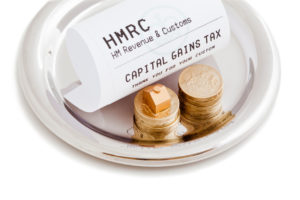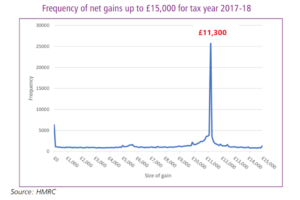From 6 April 2020, HMRC require tax on capital gains on disposals of UK residential property to be reported and paid within 30 days. This means paying tax up to 21 months earlier than under the previous rules, which is likely to catch many people unawares.
Aidan Roberson - Tax Manager - aroberson@goodmanjones.com
Posted on 9th March 2020
 Since 2015, non-UK residents have had to report and pay capital gains tax (CGT) on UK residential property within 30 days of completion (extended to UK commercial property from April 2019). This caught many people out, with late filing penalties reaching £1,600 for those who have not kept themselves up-to-date with tax rules.
Since 2015, non-UK residents have had to report and pay capital gains tax (CGT) on UK residential property within 30 days of completion (extended to UK commercial property from April 2019). This caught many people out, with late filing penalties reaching £1,600 for those who have not kept themselves up-to-date with tax rules.
Despite these issues, HMRC are now extending the reporting to UK residents disposing of UK residential property from 6 April 2020 as they seek to accelerate receipt of tax payments.
Who needs to file a return?
The new rules require a standalone CGT return to be made to HMRC in the following circumstances:
• A UK residential property is disposed of by an individual, trustee or personal representative; and
• A gain arises on the disposal; and
• The date of exchange is on or after 6 April 2020.
Partnerships disposing of UK residential property will also be affected, as their partners are taxed on their share of gains as individuals. Therefore these partners will need to complete the CGT return.
When does a return not need to be filed?
For UK residents, a return only needs to be filed for disposals of UK residential property on which a gain arises. Commercial property is not included, and neither is non-UK residential property (although disposals of these will still need to be reported on Self Assessment tax returns). Where there is no gain then a standalone CGT return does not need to be filed, for example:
• The gain is fully covered by principal private residence relief;
• There is a loss on the disposal of UK residential property;
• The gain is covered by the annual exemption; or
• The gain is covered by capital losses prior to the UK residential property disposal;
• No CGT will be due because of EIS deferral relief (or similar), so long as conditions are met at the time of disposal (i.e. the EIS investment has already been made).
The rules for reporting disposals on Self Assessment tax returns remain the same, whether or not a standalone CGT return is filed. In particular, where a claim or election is made, this must be done via the Self Assessment tax return.
Be wary when disposing of main residences on which principal private residence relief is claimed, as this relief can be limited in certain circumstances. If the relief does not fully cover the gain then a CGT return will still need to be filed if there is CGT to pay.
When do the new rules apply from?
The rules apply for disposals on or after 6 April 2020. The disposal takes place when an unconditional contract is signed (or where a conditional contract becomes unconditional), which is generally the date of exchange. If the date of exchange occurs before 6 April 2020, then a CGT return is not required even if completion is on or after 6 April. There is a large incentive to exchange contracts before this date, as the following example illustrates:
Example 1: timing of payment
John is selling a buy-to-let property, on which there is a gain of £200,000.
If he exchanges on 4 April 2020 and completes on 20 April, the gain occurs in the 2019/20 tax year and tax will be due on 31 January 2021.
If he exchanges on 10 April 2020 and completes on 20 April, the gain occurs in the 2020/21 tax year and the tax will be due on 19 May 2020, bringing forward the payment date by over 7 months.
However, it could still be advantageous for John to exchange on 10 April, if he will crystallise capital losses in the 2020/21 tax year (see example 3).
When does the return need to be filed by?
The CGT return must be made within 30 days of completion (rather than exchange, which remains the tax point in the majority of circumstances), with payment due by the same deadline. Both late filing and late payment will result in penalties, which are the same as for Self Assessment tax returns. A CGT return must be made even if the individual already submits tax returns.
Where there is a gap of many months between exchange and completion, and a Self Assessment tax return reporting the gain is filed within 30 days of completion, then a CGT return is not required. For example:
Example 2: delayed completion
Jane is selling her holiday home in Cornwall, realising a gain of £60,000. She exchanges on 23 December 2020, but completion is delayed until 3 June 2021.
Jane files her Self Assessment tax return on 20 May 2021, prior to completion. She reports the gain on the holiday home on this, so a standalone CGT return is not required. The CGT is payable on 31 January 2022, rather than 3 July 2021.
How do I file a return?
In order to make the return, an individual will need to sign up to HMRC online services and apply for a CGT account (to be made available on 6 April 2020). Those completing their own tax returns will already have an HMRC online account, but those who do not will need to factor in the time it takes to do this. Tax agents can submit returns on behalf of their clients, but HMRC have confirmed that taxpayers will still need to set up a CGT account and then provide a reference number to their agents to enable them to file on their behalf through the agent portal.
How much tax is payable?
The tax rate on gains on residential properties is 18% for basic rate taxpayers (until the basic rate is used up) and 28% for higher and additional rate taxpayers (and trustees and personal representatives). Up until now, capital gains have been reported alongside income, creating certainty of which CGT rates should be used. Presumably HMRC will request an estimate of income on the standalone CGT return, but this is yet to be confirmed.
In addition, other gains and losses in the year (e.g. on an investment portfolio) are pooled with residential property gains when calculating the overall CGT due for a given year. Where losses are incurred before a residential property gain, these can be taken into account on the CGT return. However, where losses are incurred after a residential property gain, these cannot be taken into account (unless they are UK residential losses). Instead, such losses must be claimed on the Self Assessment tax return for the year, which will lead to a repayment of tax. This is best illustrated with an example:
Example 3: timing of losses
We return to our example of John, who is selling a buy-to-let property standing at a gain of £200,000. He has capital losses in the 2020/21 tax year, so decided to exchange on 10 April 2020 and complete on 20 April 2020.
His losses are:
1. 7 April 2020: capital loss on sale of shares of £20,000.
2. 10 May 2020: capital loss on sale of commercial unit of £50,000.
3. 23 October 2020: capital loss on sale of residential property of £30,000.
John is a higher rate taxpayer, and has an annual exempt amount of £12,500 in the 2020/21 tax year. His tax is as follows:
1. The losses on the shares were incurred before the residential property gain, so can be taken into account on the CGT return required by 19 May 2020. This gives tax due on 19 May 2020 of £46,900 (being £200,000 gain less losses of £20,000 and exempt amount of £12,500 at 28%).
2. The capital loss on the sale of the commercial unit cannot be taken into account until the Self Assessment tax return is filed.
3. A CGT return is not required for the capital loss on the residential property exchanged on 23 October 2020, but one can be filed to claim tax back of £8,400 (being £30,000 at 28%).
When John files his Self Assessment tax return, his overall CGT is £24,500. He has paid £46,900 and been refunded £8,400, giving a repayment of £14,000 (the £50,000 loss on the commercial property at 28%). The earliest he can get this refund is 6 April 2021.
What if I don’t have the necessary information?
It pays to plan ahead, rather than wait until completion. Keep information on acquisition costs and enhancement expenditure on file, so that the tight timescales can be met. However, where information is not available, the rules allow for estimates to be made. These can then be updated with actual figures either by amending the CGT return or through the Self Assessment tax return.
What about non-UK residents?
There are similarities and differences with the position for non-UK residents as compared to UK residents:
Similarities:
• Non-UK residents will be required to use the new system (including setting up an HMRC online account).
• Non-UK residents must pay CGT within 30 days (i.e. they will lose the option to defer payment).
Differences:
• Non-UK residents must report all disposals, whether or not a taxable gain arises.
• Non-UK residents must report disposals of UK commercial property as well as residential.
• Non-UK residents must report indirect disposals of UK land and property via a “property rich entity”.
Planning points
The new rules are likely to catch many people unawares and may lead to cashflow issues for some. These may be alleviated by:
• Exchange before 6 April 2020 to delay the payment of CGT, unless it is otherwise disadvantageous.
• Crystallise losses before making UK residential property gains, where possible.
• Where claiming EIS or SEIS relief, make the investments before completion.
• If completion is delayed beyond the end of the tax year, file a Self Assessment return within 30 days of completion to delay payment of CGT.
CGT rates have changed since this article was written and more up to date information can be found in our 2024 Spring Budget response.
The information in this article was correct at the date it was first published.
However it is of a generic nature and cannot constitute advice. Specific advice should be sought before any action taken.
If you would like to discuss how this applies to you, we would be delighted to talk to you. Please make contact with the author on the details shown below.










 Since 2015, non-UK residents have had to report and pay capital gains tax (CGT) on UK residential property within 30 days of completion (extended to UK commercial property from April 2019). This caught many people out, with late filing penalties reaching £1,600 for those who have not kept themselves up-to-date with tax rules.
Since 2015, non-UK residents have had to report and pay capital gains tax (CGT) on UK residential property within 30 days of completion (extended to UK commercial property from April 2019). This caught many people out, with late filing penalties reaching £1,600 for those who have not kept themselves up-to-date with tax rules.






